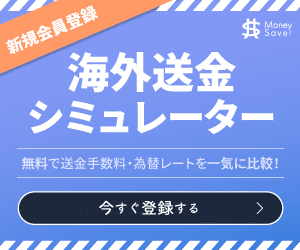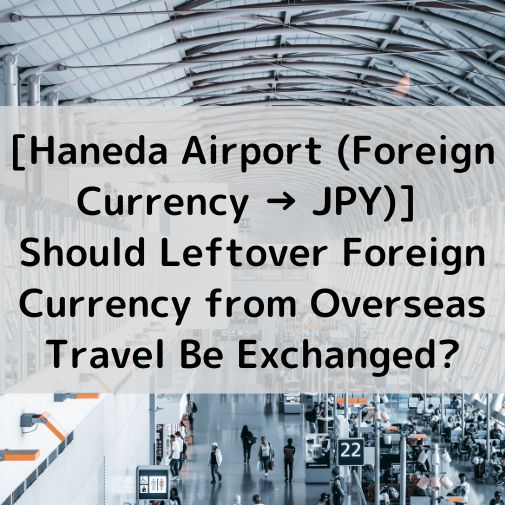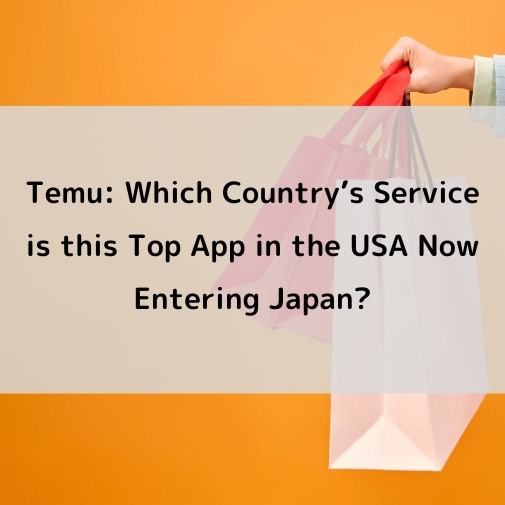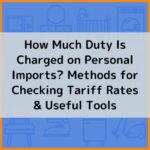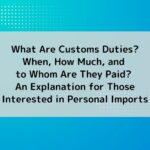How Much Duty Is Charged on Personal Imports? Methods for Checking Tariff Rates & Useful Tools
2024-10-24
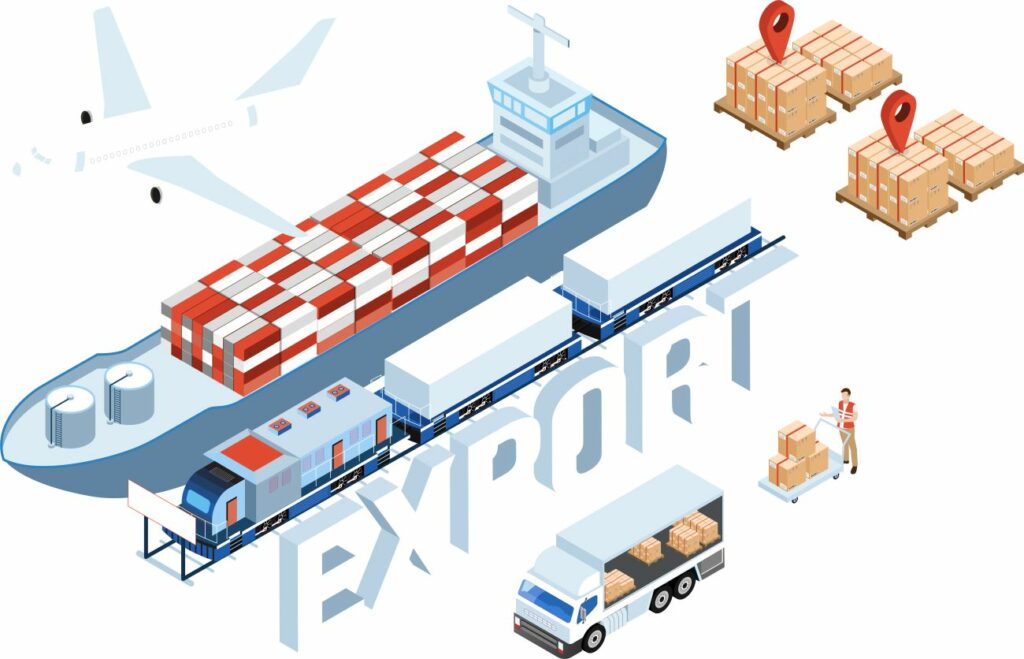
- This article is for reference only as it is merely a translated version of the Japanese article below.
個人輸入で関税はいくらかかる?関税率の調べ方・便利ツールをご紹介 (Japanese version)
With the rise of international shopping sites, personal importing has become more accessible. However, since customs procedures are often handled by shipping companies, it can be difficult to know how much duty will actually be charged.
For those looking to turn personal importing into a business, it is crucial to understand the duty costs to calculate profits accurately.
This article will explain how much duty is charged on personal imports, how to check important tariff rates, and introduce convenient tools to easily determine tariff rates.
Use this guide to estimate the amount of duty that may be applied to products you wish to import.
Another essential factor for profit calculations is the transfer fee and exchange rate at the time of payment. The “Overseas Remittance Simulator” compares the services of about 30 international remittance providers all at once! It’s free to use, so make sure to check it before sending money!
\Find the cheapest service provider in just 5 seconds!/
✅First-time use is free
How to Calculate Duty for Personal Imports

The calculation for duty on personal imports is:
Duty Amount = “Taxable Price” × “Tariff Rate”
The taxable price and tariff rate are determined by the purpose of the import and the value of the goods.
Taxable Price for Personal Imports Varies by Purpose
The taxable price depends on whether the goods are imported for personal use or for commercial purposes, such as resale.
When Importing for Personal Use
If goods are imported for personal consumption, the taxable price is “60% of the overseas retail price.” Additionally, if the taxable price is less than 10,000 JPY, no duty will be charged.
For Commercial Purposes
For goods imported for commercial purposes, such as resale, the taxable price is “overseas retail price + shipping costs to the import port + insurance.”
Tariff Rates for Personal Imports Differ Based on the Value
Another element in calculating duty is the “tariff rate.” There are two types: the “general tariff rate,” which applies to trade transactions where the taxable price exceeds 200,000 JPY, and the “simplified tariff rate,” which applies to small imports with a taxable price between 10,000 JPY and 200,000 JPY.
Simplified Tariff Rate for Goods Valued Between 10,000 JPY and 200,000 JPY
When the total taxable price in a single import declaration is less than 200,000 JPY, the simplified tariff rate is applied. For postal items, this applies to packages where the total taxable price is also less than 200,000 JPY.
However, if items are sent separately from the same sender to the same recipient at the same time due to weight restrictions or other reasons, the total taxable price of all the separate packages will be summed up.
The simplified tariff rate categorizes general tariff rates into seven major groups and can be applied to both personal and commercial imports. Compared to the standard tariff rates, the simplified rates are easier to understand and calculate.
For more details on the simplified tariff rate, refer to “Customs: Simplified Tariff Rates for Small Imports.”
General Tariff Rate for Goods Valued Over 200,000 JPY
The general tariff rate applies to standard commercial goods where the taxable price exceeds 200,000 JPY. For example, this would apply to large shipments carried by container ships.
How to Check Tariff Rates?
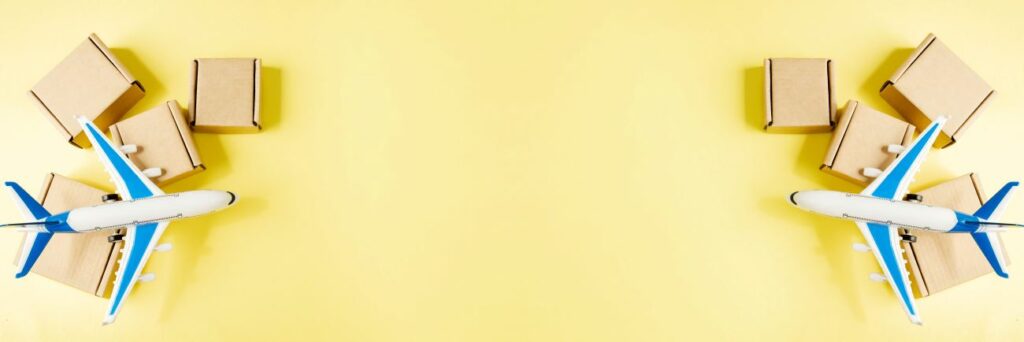
There are three main ways to check the tariff rates for items intended for import:
- Check the Tariff Rate Table from Customs
- Use the Japan Customs Association’s Web Tariff
- Utilize the Customs Advance Classification Ruling System
Each method will be explained below.
Checking with the Tariff Rate Table: Customs
The Tariff Rate Table allows users to confirm the tariff rates applied when importing goods into Japan. It is available on the Japan Customs website, and anyone can access it by following these steps:
- Go to the Japan Customs website and navigate to “Export/Import Procedures.”
- Select “Tariff Rate Table.”
- Choose “Export and Import Statistical Items (Tariff Rate Table).”
The Tariff Rate Table is updated several times a year whenever there are changes in tariff rates due to national decisions or new agreements, such as EPAs (Economic Partnership Agreements) with foreign countries. Since updates happen frequently, always select the latest version at the top of the list.
Now, let’s see how to check the tariff rate for coffee using the Export and Import Statistical Items (Tariff Rate Table).
The Tariff Rate Table categorizes goods from around the world into 21 main sections, which are further divided into 97 groups. Coffee beans fall under Section 9.
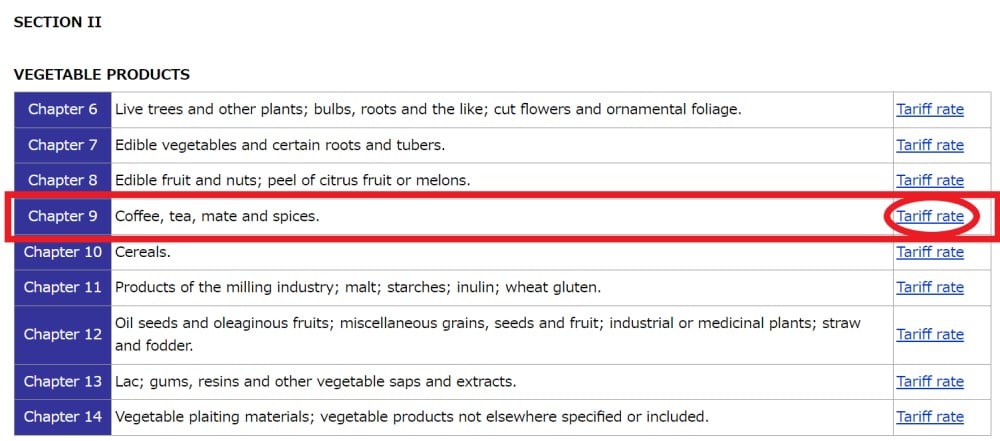
Next, clicking on the tariff rate will reveal detailed classifications of coffee, such as roasted or unroasted, decaffeinated or not.
For “roasted, decaffeinated coffee,” the basic tariff rate is 20%. If the coffee originates from a country that has signed a WTO agreement, the rate is reduced to 12%. Furthermore, if the preferential tariff rate is applied, it drops to 10%.
Additionally, if the country of origin has signed an Economic Partnership Agreement (EPA) with Japan, lower rates determined for each country may apply.
Tariff rates are generally applied in the following order of priority: Preferential Rate → Agreement Rate → Provisional Rate → Basic Rate.
Note: The preferential rate is only applicable under specific conditions, among other cases. For more details, refer to “The Flow of Tariff Determination” on the Japan Customs website.

Searching Tariffs via Web Tariff: Japan Tariff Association
The Web Tariff is a service operated by the Japan Tariff Association that allows users to check tariff rates, similar to the official Tariff Schedule.
When accessing the Japan Tariff Association‘s “Web Tariff,” the following page will be displayed.
With the Web Tariff, users can select the country of origin or region and search using options like “Browse List,” “Statistical Number,” or “Keyword.”
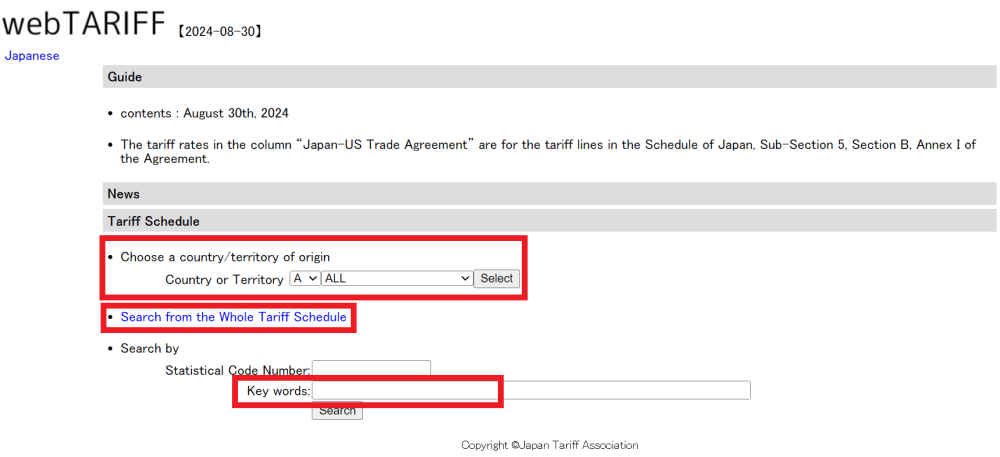
If browsing by list, select a country or region and click “Browse List.”
For example, let’s search for roasted coffee beans, excluding caffeine, originating from the Philippines. Coffee falls under Section 02, “Vegetable Products,” and Chapter 09, “Coffee, Tea, Mate, and Spices.”
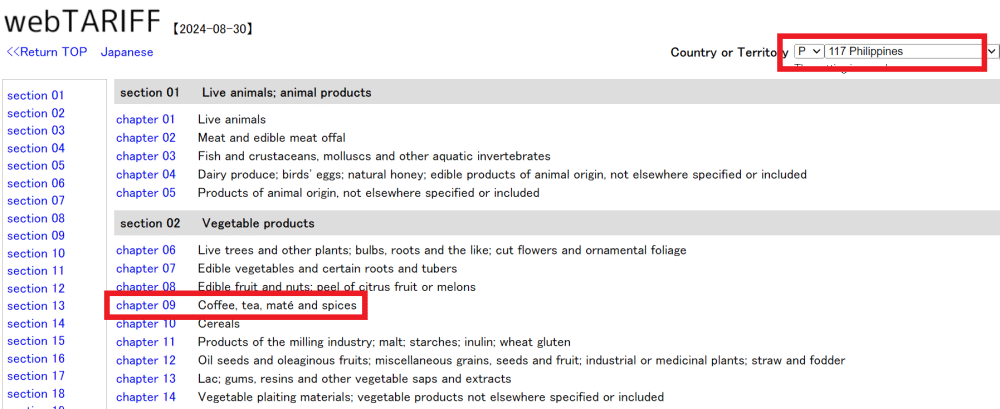
Once detailed information is displayed, click on the HS code of the item to be examined.
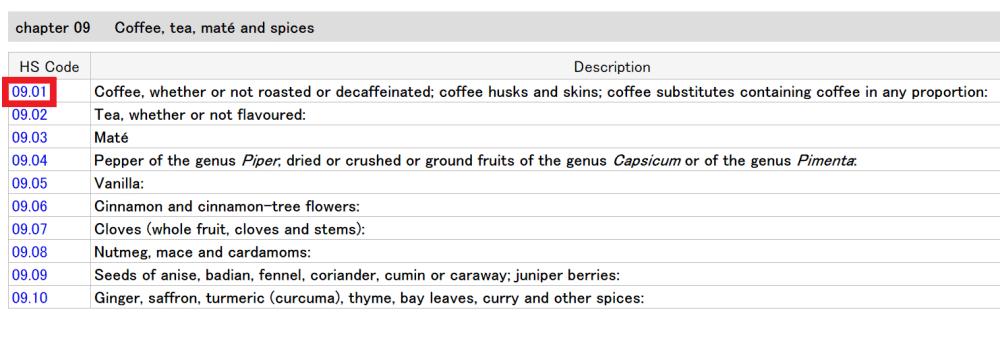
A list of items under Chapter 09 will appear. Check the section for “Roasted Coffee Beans, Decaffeinated.” The basic tariff rate is 20%, but if the country of origin is a WTO member, the rate is 12%. Furthermore, a preferential rate may apply, reducing it to 10%.
For the Philippines, since there is an Economic Partnership Agreement (EPA), the product can be imported duty-free.

The Web Tariff has another convenient feature: the ability to check “Other Legal Regulations.” For some items, permission from other agencies may be required to receive customs clearance. This is called “Other Legal Regulations,” and about 30 different regulations are in place.
By clicking the three-digit number in the statistical subdivision of the relevant item, the following screen will appear.
In this case, the item may be subject to the Plant Protection Act and the Food Sanitation Act, so it is necessary to follow the procedures stipulated by each of these laws.
Note: The listed applicable laws may not apply to all products.
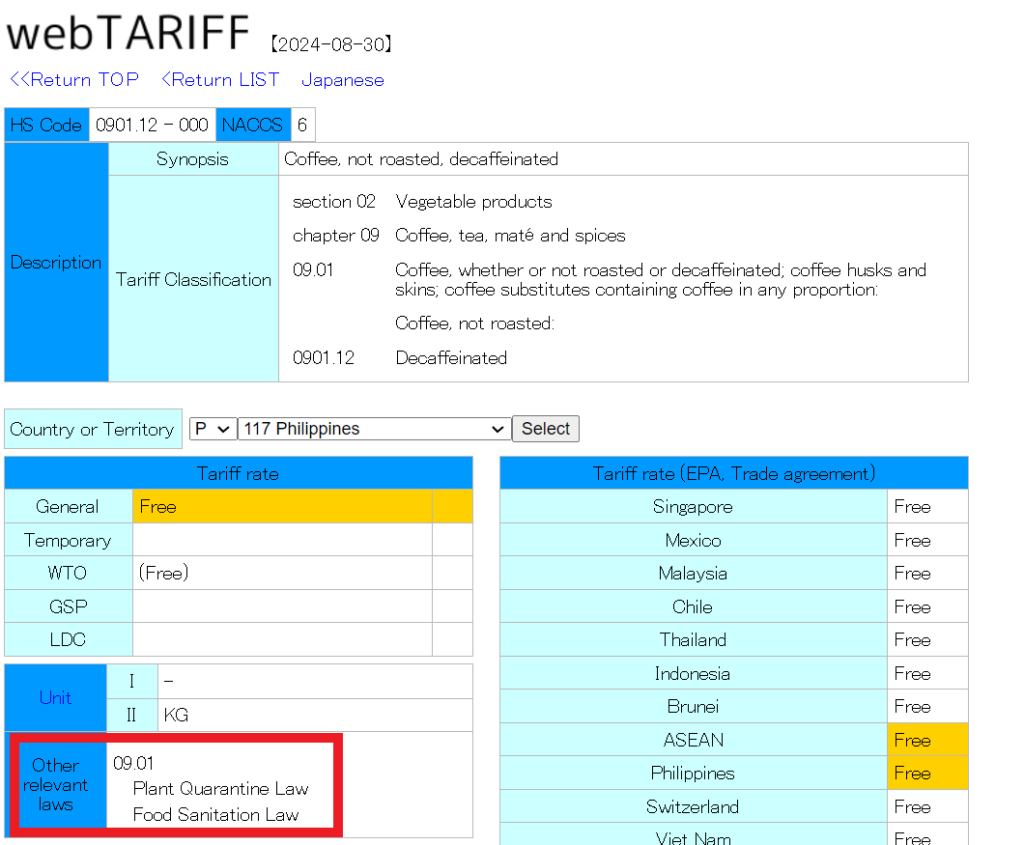
Using the Advance Classification Ruling System: Customs
To determine the correct tariff rate, it is essential to classify the item according to the appropriate number in the Tariff Rate Table. This process can require specialized knowledge, which may be difficult for beginners.
In such cases, utilizing the “Advance Classification Ruling System” from Customs is recommended. This system allows users to confirm the tariff rate for an item they plan to import in advance by contacting Customs via document or email.
Additionally, inquiries can be made by phone to the Customs Consultation Office, and past examples of advance rulings (item classification) can be searched on the Customs website.
If there are any doubts about the self-determined tariff rate, consider consulting with Customs.
Customs Customs Answer: “About the Advance Classification Ruling System“
Customs Customs Answer: “List of Contact Points for Customs Consultation“
What is the HS Code Required to Check Tariff Rates?
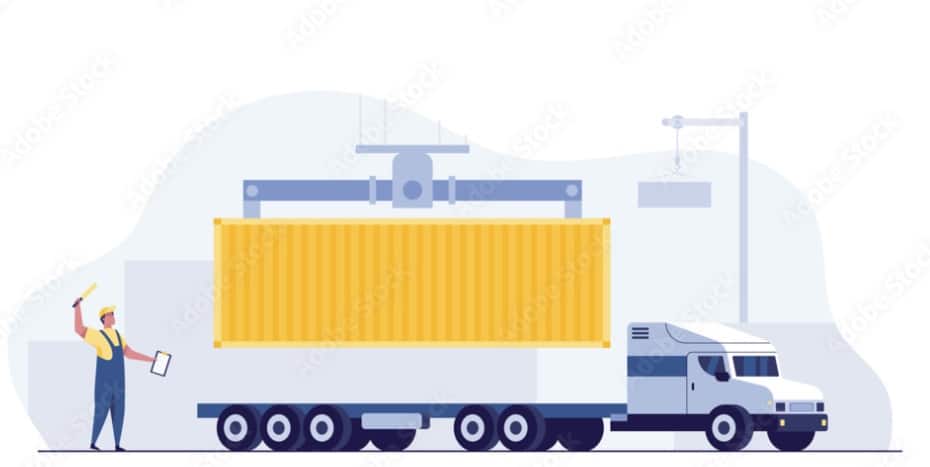
The number used in the Tariff Rate Table is called the “HS Code.” Officially, this stands for the “Harmonized Commodity Description and Coding System,” a uniform system for naming and classifying goods.
Every product traded internationally has an HS Code, and Japan has used this system since the HS Convention came into effect in 1988. The HS Code is also referred to by various names, including “HS Number,” “Export and Import Statistical Item Number,” “Tariff Number,” or “Tax Number.”
The Role of the HS Code
The HS Code is an item classification number assigned to goods being imported or exported. It ensures a standardized understanding of what a product is, no matter where it is being traded.
Even if product names vary across countries, or if the product name alone does not clearly indicate its characteristics, the HS Code makes it possible to identify what the product specifically is.
The HS Code can be used to check the applicable tariff rates for a product and the rules of origin (criteria indicating the country from which a product originates).
Structure of the HS Code
The first six digits of the HS Code are universally standardized, while subsequent digits further classify items and may differ between countries. Generally, the HS Code refers to the initial six digits.
The HS Code is structured into “Chapters,” “Headings,” and “Subheadings,” starting from broad “Sections” and narrowing down to specific items.
For example, the HS Code for “roasted, decaffeinated coffee beans” is 090122000, following this structural format.
| Class | Heading | Subheading | Statistical Subdivision (last 3 digits) |
| 09 | 01 | 22 | 000 |
| Coffee, tea, mate, and spices | Coffee (whether roasted or not, or whether decaffeinated or not). Coffee husks and skins, as well as coffee substitutes containing coffee (regardless of the amount of coffee content). | Coffee (limited to roasted) that is decaffeinated. | Varies by country |
Points of Caution for Personal Importing
When engaging in personal importing, it is important to be aware of prohibited and regulated items, as well as quantity restrictions for pharmaceuticals and cosmetics.
| Categories | Conditions | Permissible Import Quantity |
| Pharmaceuticals and Quasi-Drugs | Exceptions for import without a pharmaceutical approval certificate | External preparations: Up to 24 standard-sized units Poisonous substances, powerful drugs, prescription medications: Up to a 1-month supply Others: Up to a 2-month supply |
| Cosmetics | For general personal use | Up to 24 standard-sized units (e.g., for lipstick, up to 24 units regardless of brand or color) |
| Medical Devices | – Household medical devices (e.g., massagers): 1 set – Disposable medical devices (e.g., disposable contact lenses): 2 months’ supply – External diagnostic agents (e.g., ovulation test kits): 2 months’ supply | Quantity based on usage and dosage |
| Regenerative Medicine Products | For personal use (pharmaceuticals or medical devices used to repair, regenerate, or improve damaged tissues or bodily functions) | Up to a 1-month supply |
| Controlled Substances | Narcotics, psychotropic drugs, and raw materials for stimulants cannot be imported without a prescription from a doctor. | Quantity based on a doctor’s prescription |
| Other Important Considerations | The import of designated substances, items restricted under the Washington Convention, and goods that infringe on intellectual property rights is prohibited. |
Here are key points to keep in mind when importing as an individual:
- When importing pharmaceuticals and similar products for personal use, it is essential to note that they are generally intended solely for self-use. Selling or transferring these items to others is strictly prohibited.
- Products containing specific ingredients or those marketed overseas as enhancing brain function may pose health risks or potential for misuse. Therefore, importing them is not permitted without a prescription from a physician.
- For drugs subject to import regulations, violations can lead to legal penalties.
※ For reference, if a tablet is to be taken three times a day, with a dose of two tablets per intake, a two-month supply would amount to 3 times × 2 tablets × 60 days = 360 tablets.
Summary
This article provided an overview of the customs duties associated with individual imports, how to check tariff rates, and introduced convenient tools for easily determining these rates. For those considering starting a business through individual imports, this information should serve as a helpful reference.
Another important aspect not to overlook when calculating profits is the remittance fee and exchange rate during payment. The “Overseas Remittance Simulator” allows users to compare services from about 30 overseas remittance providers at once! It is free to use, so be sure to check it before making any transfers.
\Find the cheapest service provider in just 5 seconds!/
✅First-time use is free


 Language
Language
